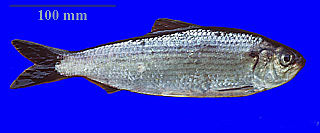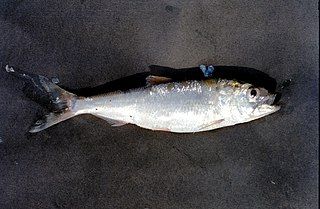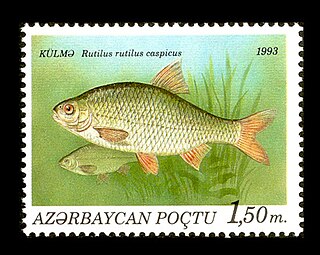
The alewife is an anadromous species of herring found in North America. It is one of the "typical" North American shads, attributed to the subgenus Pomolobus of the genus Alosa. As an adult it is a marine species found in the northern West Atlantic Ocean, moving into estuaries before swimming upstream to breed in freshwater habitats, but some populations live entirely in fresh water. It is best known for its invasion of the Great Lakes by using the Welland Canal to bypass Niagara Falls. Here, its population surged, peaking between the 1950s and 1980s to the detriment of many native species of fish. In an effort to control it biologically, Pacific salmon were introduced, only partially successfully. As a marine fish, the alewife is a US National Marine Fisheries Service "Species of Concern".

The American shad is a species of anadromous clupeid fish naturally distributed on the North American coast of the North Atlantic, from Newfoundland to Florida, and as an introduced species on the North Pacific coast. The American shad is not closely related to the other North American shads. Rather, it seems to form a lineage that diverged from a common ancestor of the European taxa before these diversified.

Alosa is a genus of fish, the river herrings, in the family Alosidae. Along with other genera in the subfamily Alosinae, they are generally known as shads. They are distinct from other herrings by having a deeper body and spawning in rivers. Several species can be found on both sides of the Atlantic Ocean and the Mediterranean Sea. Also, several taxa occur in the brackish-water Caspian Sea and the Black Sea basin. Many are found in fresh water during spawning and some are only found in landlocked fresh water.

The Persian sturgeon is a species of fish in the family Acipenseridae. It is found in the Caspian Sea and to a lesser extent the Black Sea and ascends certain rivers to spawn, mainly the Volga, Kura, Araks and Ural Rivers. It is heavily fished for its flesh and its roe and is limited in its up-river migrations by damming of the rivers. Young fish feed on small invertebrates, graduating to larger prey such as crabs and fish as they grow. The threats faced by this fish include excessive fishing with the removal of immature fish before they have bred, damming of the rivers, loss of spawning areas and water pollution. The International Union for Conservation of Nature has listed the fish as critically endangered and has suggested that the increased provision of hatcheries could be of benefit.

The allis shad is a widespread Northeast Atlantic species of fish in the Alosidae family. It is an anadromous fish which migrates into fresh water to spawn. It is found in the eastern Atlantic Ocean, the western Baltic Sea and the western Mediterranean Sea. In appearance it resembles an Atlantic herring but has a distinctive dark spot behind the gill cover and sometimes a row of up to six spots behind this. It sometimes hybridises with the twait shad. This fish becomes mature when three or more years old and migrates to estuaries, later swimming up rivers to spawn. Populations of this fish have declined due to overfishing, pollution and habitat destruction. Conservation of this species is covered by Appendix III of the Bern Convention and Appendix II and V of the European Community Habitats Directive.

The twait shad or twaite shad is a species of fish in the family Alosidae. It is found in the eastern Atlantic Ocean and the Mediterranean Sea and is an anadromous fish which lives in the sea but migrates into fresh water to spawn. In appearance it resembles an Atlantic herring but has a row of six to ten distinctive spots on its silvery flanks. They become mature when three or more years old and migrate to estuaries, later swimming up rivers to spawn. Populations of this fish have declined due to overfishing, pollution and habitat destruction. Conservation of this species is covered by Appendix III of the Bern Convention and Appendix II and V of the European Community Habitats Directive.

Alosa macedonica, or the Macedonian shad, is a landlocked species of alosid fish endemic to Greece. Its single natural occurrence is the freshwater Lake Volvi in northern Greece. It is threatened by habitat loss.

Alosa maeotica, known as the Black Sea shad or Azov shad, is a species of Alosid fish endemic to the Sea of Azov and the western part of the Black Sea basin. It is found in Bulgaria, Georgia, Moldova, Romania, Russia, Turkey, and Ukraine.
Alosa vistonica the Thracian shad, is a species of shad, a freshwater fish in the family Alosidae. It is endemic to a single shallow lake, Lake Vistonida in Greece. It is classified as critically endangered (CR) and is threatened by sewage, industrial effluents, destruction of spawning sites by agricultural development and increased salinity following the opening of a canal into the sea. It has been suspected to be extinct already.

Alosa caspia is a species of [[alosid]] fish, one of the species of shad endemic to the Caspian Sea basin.

The blueback herring, blueback shad, or summer shad is an anadromous species of herring from the east coast of North America, with a range from Nova Scotia to Florida. Blueback herring form schools and are believed to migrate offshore to overwinter near the bottom.
The Kura bleak is a species of ray-finned fish in the genus Alburnus. It is native to the Caspian Sea basin, from the Kura River and Aras River in the east to the Sefīd-Rūd in Iran.
Alosa algeriensis, the North African shad, is a Mediterranean species of clupeid fish in the shad genus Alosa.

Alosa braschnikowi, the Caspian marine shad or Brazhnikov's shad, is one of the alosid fish species endemic to the Caspian Sea.

The Pontic shad, also referred to as the Black Sea shad or Kerch shad, is a species of clupeid fish in the genus Alosa, native to the Black Sea and Sea of Azov basins.
Alosa kessleri, also referred to as the Caspian anadromous shad, the blackback, or the black-spined herring, is a species of alosid fish. It is one of the several species of shad endemic to the Caspian Sea basin.
Alosa sphaerocephala, or the Agrakhan shad, is a species of alosid (herring-like) fish, one of the endemic shad species in the Caspian Sea.

Alosa tanaica, known as the Azov shad or Black Sea shad, is a species of alosid fish endemic to the Ponto-Caspian basin. It is an anadromous species, spawning in the lower reaches of rivers. It is widespread in the eastern Black Sea, the Kerch Strait and the Sea of Azov.
Alosa volgensis, the Volga shad, is a alosid fish, one of the species of shad endemic to the Caspian Sea region.

The Caspian roach is a species of roach fish living in the Caspian Sea. The Caspian roach can be distinguished from other roaches by its laterally compressed body, silvery grey iris, rounded snout and grey pectoral pelvic and anal fins with dark margins. The Caspian roach is semi-anadromous and inhabits mostly shallow coastal waters. It enters Volga, Ural, Emba, Terek and Kura drainages for spawning.













